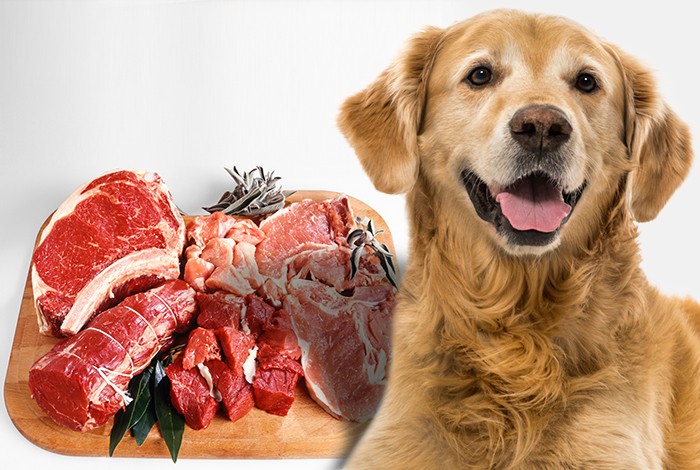![]() Reviewed By Joana Garrido DVM
Reviewed By Joana Garrido DVM
Dogs may be omnivorous, but meat is still a vital part of their diet. Meat protein is a valuable source of essential amino acids vital to your dog’s overall health.
However, not all meats are equal, as some meats offer dogs more nutritional benefits than others. To narrow down the search, here are the top 13 best types of meat for your dog.
1. Beef
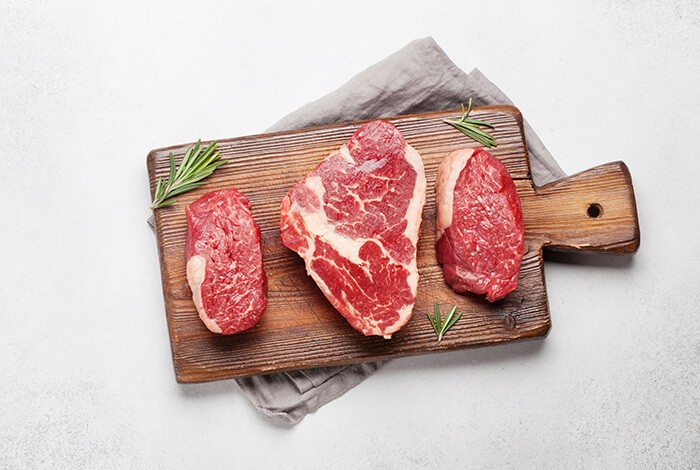
Beef is a commonly used ingredient in countless dog foods. It is a popular choice among many dog owners.
It is nutritious and affordable, and most importantly, dogs love it. Beef is an excellent source of iron, selenium, and zinc. It also contains vitamins B3, B6, and B12.
Red meat, in general, is high in protein and rich in iron and vitamin B12. In addition, leaner cuts of unprocessed red meats are healthier for dogs as they contain less fat.
Keep in mind that beef is one of the most common allergy triggers in dogs. Therefore, if your dog has a history of food allergies or intolerances, you may need to consider choosing another type of meat.
If you are not aware that your dog is allergic to beef, observe him after he has consumed the meat. Common signs of allergic reaction to food are:
- Chronic skin and ear infections
- Itchy skin
- Vomiting
- Diarrhea
Stop feeding your dog beef if he suffers from these symptoms, and seek veterinary advice.
2. Pork
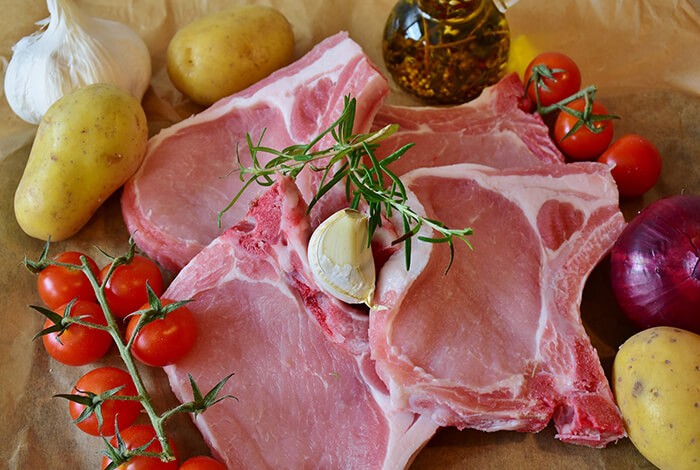
Pork is a great source of protein, B vitamins, iron, selenium, and zinc. This meat’s downside is that it is significantly high in fat. Pork is not a good addition to a senior or sedentary dog’s diet.
Be sure to choose high-quality, fresh pork. Never feed your dog cured pork products such as bacon and ham. These items are high in sodium and spices, which have a terrible effect on dogs’ health.
Ensuring that the pork comes from a reputable source is crucial as well.
Pigs that are farmed in stressful and poor living conditions are highly susceptible to a disease called porcine stress syndrome (PSS).
This is a genetically transmitted disease that is triggered by excitement or stress.
PSS can significantly affect the quality of the pork. Some pigs suffering from PSS may yield pale, soft, and exudative (PSE) muscles.
This is often viewed as low-quality due to its unappealing, mushy, and loose texture. It is very different from high-quality fresh pork, which is reddish pink, firm in texture, and significantly free from surface juices.
Similar to beef, pork is a prevalent food allergen in dogs. So keep watch on your dog when feeding it to him. If he displays signs that indicate pork allergy, do not include it in his meals and ask for help from the vet.
3. Bison

Bison’s texture and taste are a lot like beef. However, compared with beef, bison has a lower protein content.
However, on the plus side, bison is a very lean meat, so it is lower in sodium and saturated fat than beef or pork.
This popular red meat is a good source of omega-3 fatty acids and conjugated linoleic acid. Moreover, it is rich in vitamin B12, iron, niacin, selenium, and zinc.
4. Chicken
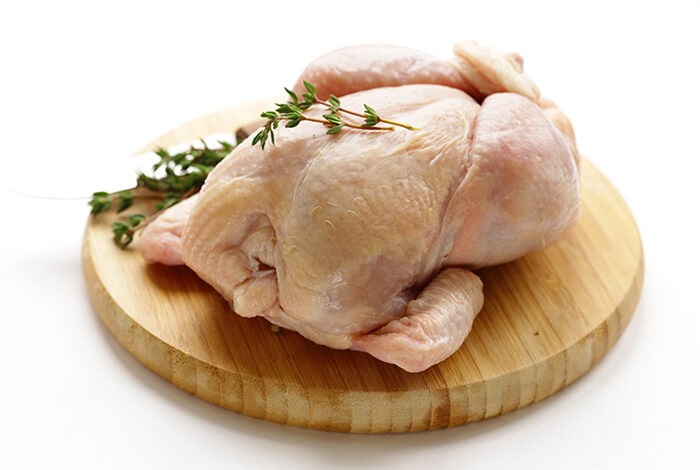
Like beef, chicken is one of the major meat sources in dog food. It is an affordable meat protein source for our furry companions.
Chicken contains more protein and less fat compared to beef and pork. Other essential nutrients in chicken include vitamins B3 and B6, phosphorous, and selenium.
When choosing chicken, do not pick commercially produced ones. They are not the best options since they are poorly bred and usually contain high amounts of antibiotics.
The healthier alternative is organic or free-range chickens. They live outdoors and are fed on chemical-free feeds. Moreover, they are free from growth hormones or antibiotics.
Studies show that organic and free-range chicken meat has less fat and higher protein, iron, and zinc nutrients than conventional birds.
Beware of Salmonella bacteria, which easily thrive in chickens. However, we are actually more at risk than our dogs.
So always place raw meat and poultry in a separate area from other food and groceries. Also, be sure to wash your hands and kitchen utensils after handling uncooked poultry.
Chicken is one of the most common food allergens for dogs. Watch out for signs of an allergic reaction the first time he is fed chicken. If he shows them, stop feeding him chicken and consult the vet.
5. Turkey

Turkey is an excellent protein source for dogs. It is leaner and has lower fat content compared to chicken. Turkey is also rich in:
- Vitamin B6
- Iron
- Niacin
- Phosphorous
- Potassium
- Zinc
Opt for the breast meat, not the legs and skin, since this part has less fat.
However, turkey is often more expensive than chicken. This can be due to many factors, including the turkey requiring more feed and needing more space since they are large birds.
There is also the rising cost of turkey feed, which makes sellers consider hiking up the price. Turkey meat prices shoot up during holidays like Christmas and Thanksgiving as the demand for it is higher at these times.
Turkey is prone to Salmonella contamination, just like chicken. Thus, proper hygiene practices should be carried out.
Make sure to clean surfaces and items that have come into contact with raw turkey with great care. Be sure to wash your hands properly after handling the meat.
6. Venison
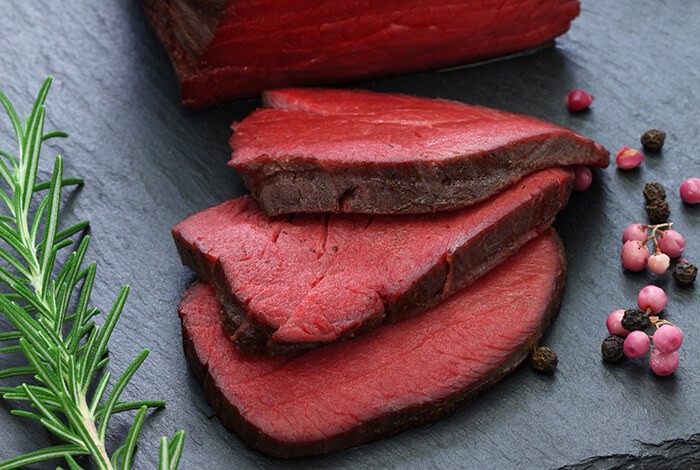
Venison contains a similar caloric density to chicken. However, it has more fat and less protein than chicken.
While it might not be the best choice for senior dogs and obese dogs, venison is a good option for dogs with allergies. It is considered a unique protein source that is used to manage their condition.
7. Lamb
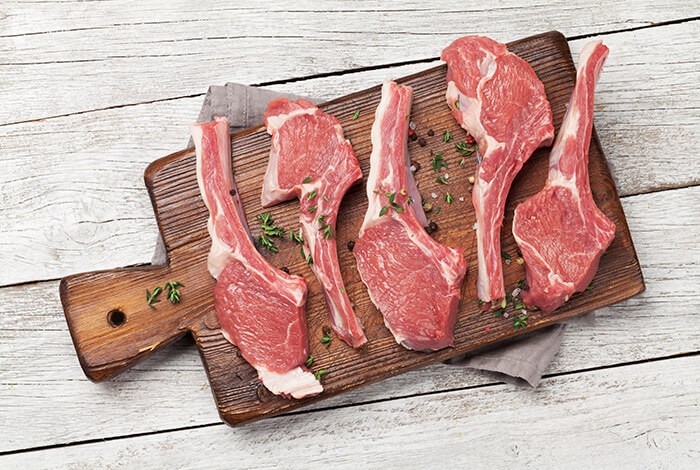
Compared to other types of meat, lamb is a lot leaner and contains more proteins. It also contains omega-3 fatty acids.
Sheep are mostly grass-fed and roam freely in a healthy and stress-free environment. As a result, lamb is packed with:
- Vitamins B3 and B12
- Selenium
- Zinc
- Omega-3 and omega-6 fatty acids
Like turkey, lamb is considered a novel protein source and a great alternative to common meat allergens. This meat is now widely used in dog food to prevent allergic reactions in dogs and cats.
8. Goat
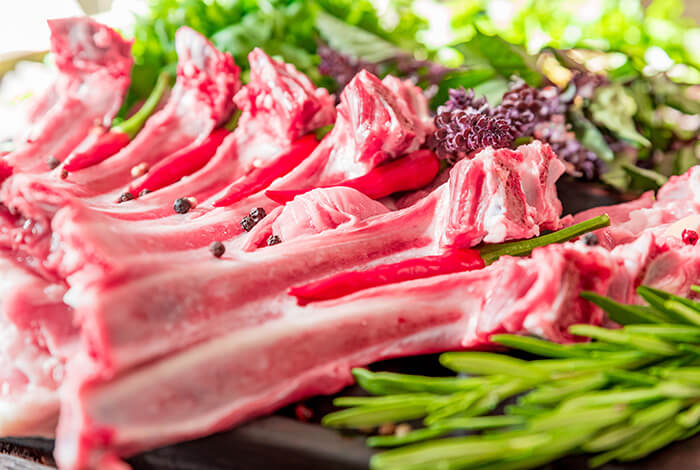
Goat meat has lower cholesterol, fat, and calories than beef, chicken, lamb, and pork. Most importantly, it has higher protein levels and is a great source of iron.
Young goat meat is more tender and has a milder flavor than lamb. However, meat from older goats is tougher to chew on and has a stronger taste.
9. Kangaroo
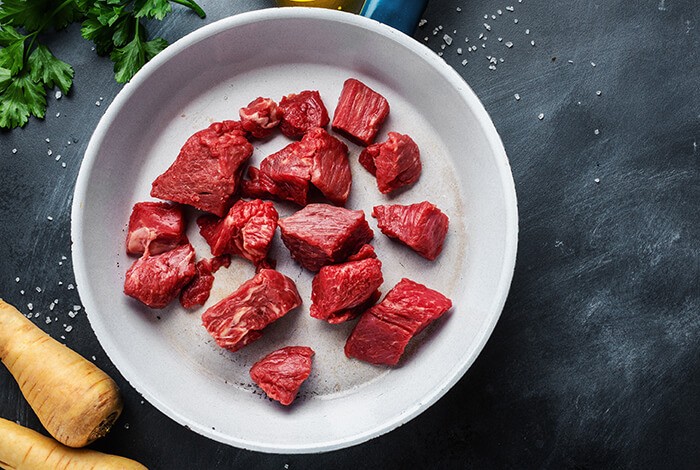
Kangaroo is one of the least fatty meats on our list. It only has a fat content of 2% to 3%. Kangaroo is a valuable source of protein, vitamins, and minerals for dogs. It contains vitamin B, iron, omega-3 fatty acids, and zinc.
Kangaroo meat is mostly produced from the ones caught in the wild. Thus, it is organic, leaner, and healthier than most red meat on the market. For this reason, it is an ideal meat choice for dogs with food allergies.
10. Salmon
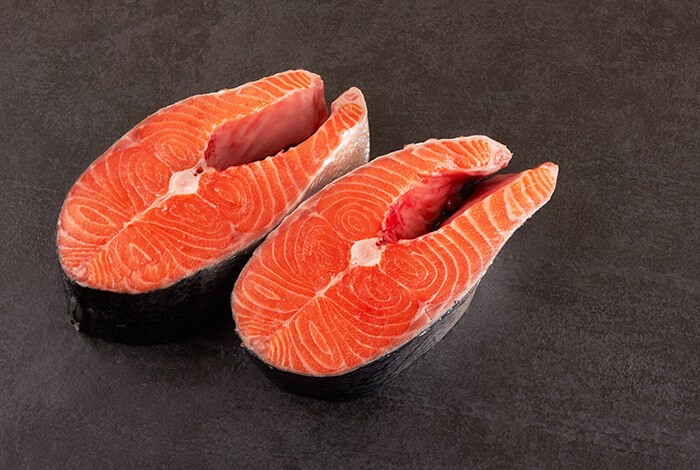
Salmon is rich in protein content. It is also high in omega-3 fatty acids and is known to effectively reduce inflammation, thereby preventing some chronic diseases.
Salmon is also abundant in B vitamins, including vitamins B6 and B12.
When it comes to feeding fish to dogs, there is a general worry about freshwater fish containing high levels of mercury.
Fortunately, wild salmon coming from countries with fewer water contaminants have low levels of mercury.
So when choosing salmon for your dog, pick the ones from Canada or Scandinavia, as these waters have lower pollution levels.
Avoid purchasing salmon coming from the waters of the United States because of its high harmful chemical level.
Many vets advise against serving raw salmon as it is harmful to dogs. This type may contain Neorickettsia helminthoeca parasites, which are the main cause of salmon poisoning.
This alarming condition will cause dogs to suffer from fever, diarrhea, dehydration, and vomiting. Only serve properly cooked salmon to your pup to avoid this danger.
11. Ostrich
 The protein levels of ostrich rival that of beef and pork. However, unlike these two types of meat, it contains lesser amounts of fat and calories. Thus, it is a great protein choice for dogs that need to shed some pounds.
The protein levels of ostrich rival that of beef and pork. However, unlike these two types of meat, it contains lesser amounts of fat and calories. Thus, it is a great protein choice for dogs that need to shed some pounds.
Ostrich meat is valued as a novel protein. Pooches with food allergies linked to animal protein can benefit from having it in their meals.
On the downside, ostrich is rare and difficult to obtain. Dog owners need to have a reliable source before making this meat a staple in their canine companions’ diets.
12. Pheasant
 Pheasant has become a common ingredient in game bird dog food recipes. Its high protein content, which exceeds that of chicken, may have contributed to its rise in popularity.
Pheasant has become a common ingredient in game bird dog food recipes. Its high protein content, which exceeds that of chicken, may have contributed to its rise in popularity.
Pheasant is not a great fit for chubby dogs, however, because it contains more fat and calories. Underweight canines can take advantage of these qualities the meat has.
13. Rabbit
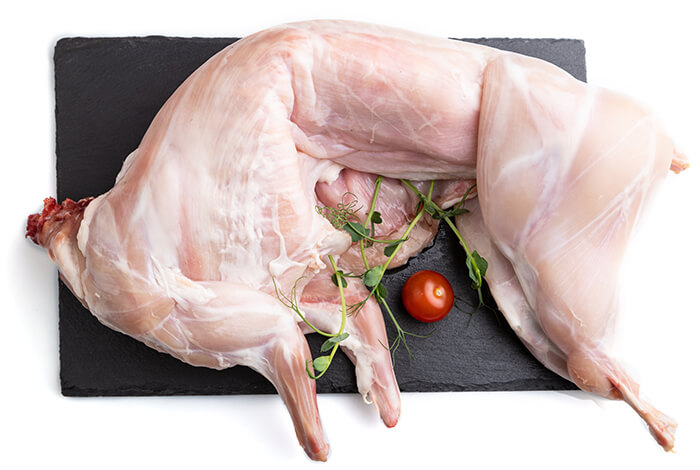
Rabbit contains nearly the same amount of protein as chicken and turkey. It is leaner compared to other types of meat, thus it has lower levels of calories, cholesterol, and fat.
Moreover, because it is highly digestible, your canine friend’s stomach will have no trouble breaking rabbit meat down and absorbing its nutrients properly.
What Is the Best Meat for Your Dog?

Choosing the best meat for your dog can be a challenging task. It’s essential to consider your dog’s unique nutritional requirements before deciding on a protein source. Consulting your veterinarian is a great place to start, as they can evaluate your dog’s age, breed, size, and energy level and recommend the appropriate type of meat.
While there is some research linking exotic meat to canine dilated cardiomyopathy (DCM) due to low taurine levels, the evidence is uncertain. Even common protein sources such as lean cuts of beef, skinless chicken breast, and turkey breast have lower levels of taurine compared to organ meats like liver, heart, and kidneys.
If you decide to feed your dog a homemade diet, it’s crucial to ensure it’s balanced and meets all of their nutritional needs.
What About Organ Meats?
Organ meats are a great addition to your dog’s diet because they are a powerhouse of nutrients like iron, selenium, and zinc.
However, they must be added to his meals very sparingly to avoid nutrient overdose.
Certain types of organ meats, such as the liver, provide high doses of vitamin A. Excessive intake can cause hypervitaminosis A, which can result in severe poisoning.
How Much Protein Do Dogs Need?

There is no standard amount of protein intake for canines. The protein needs of each dog will vary depending on their age, activeness, breed, health, and size.
The general guideline to follow is to feed your dog 1 gram of high-quality protein per pound of his ideal body weight.
For instance, if your furry pal’s ideal body weight is 65 pounds, he will need 65 grams of high-quality protein daily.
Keep in mind that your calculations should not be based on your dog’s actual body weight. Otherwise, it will yield excessive protein, which can play a part in the development of obesity and kidney problems.
Is It Wise to Feed Your Dog a Homemade Food?

Homemade dog food is a healthier alternative to commercial dog kibble. However, it requires more time and money, and a lot of thought during preparation.
Dog owners cannot simply put together homemade dog food on their own. Many have tried and it has caused their dogs to suffer from nutritional imbalances.
You will need to work with the vet and a canine nutritionist to come up with a homemade dog food that caters to your pooch’s specific nutritional needs.
Another big challenge when preparing meals for your dog is sanitation. Thorough cleaning of utensils used and surfaces exposed to raw meats should be done to prevent the risk of foodborne diseases.
Note that humans are more in danger of catching these health hazards than their canine companions.
Preparing Meat for Dogs
Here are a few reminders when preparing meat for your dog:
If possible, always opt for organic and free-range meats. Human-grade meats are good options too. These are free from or contain fewer hormones and chemicals.
The meat should be boneless. Cooked bones can easily splinter and cause injury to dogs’ mouths and digestive tracts. They can also cause choking and stomach obstruction.
Introduce meat to dogs gradually. Sudden changes to their diet may affect their sensitive digestive systems.
This can lead to an upset stomach, diarrhea, and vomiting. It is also advisable to chop the meat into small pieces to make it easier for dogs to digest.
FAQs About Meat for Dogs

What Meat Should Dogs Avoid?
Processed meats such as ham, salami, bologna, and pepperoni are the types of meat dogs should avoid. They tend to have high concentrations of sodium, which can cause kidney problems and other health issues.
Some of them also contain toxic ingredients to pooches, such as onion or garlic powder.
What’s Better for Dogs: Chicken or Beef?
In most cases, chicken is better for dogs than beef because it is high in protein but contains less fat.
However, it does not mean you should swear your dog off beef. Opting for leaner cuts of this type of meat helps reduce its fat content.
What Meat Is Easiest for Dogs to Digest?
Chicken meat is easiest for dogs to digest, especially when boiled and shredded. Because of this, it is a common ingredient in bland food for canines with stomach upsets.
Can My Dog Eat Meat Every Day?
Your dog can eat meat every day, provided that it is part of a nutritionally balanced diet. If you plan to include meat in your dog’s daily meals, inform the vet to ensure that it is a suitable addition.
Keep in mind that dogs with health issues like kidney or liver disease may require lower protein intake to keep their affected organs from overworking.
Summary
 Animal meats are not created equal. Some varieties, such as chicken, turkey, beef, and lamb offer more proteins to dogs than others.
Animal meats are not created equal. Some varieties, such as chicken, turkey, beef, and lamb offer more proteins to dogs than others.
Dog owners should also take into consideration the fat content. Meats like pork and venison are often high in fats. Hence, they are not the best pick for obese dogs, geriatric canines, and other pooches that have fat intake restrictions.
Another great food choice to incorporate into your dog’s diet is offals. Read our article Organ Meats for Dogs: An Important Part of Your Dog’s Diet to know how they can improve his overall health.

